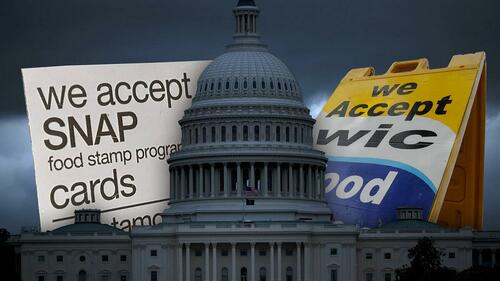Why Are 42 Million Americans Relying On SNAP Benefits?
Amid the furious debate over the government shutdown and the incoming freeze of SNAP food benefits, one important factor is often overlooked – Why are 42 million Americans, a number larger than the entire population of Canada, dependent on government subsidized groceries? Isn’t this a time bomb waiting to explode regardless of a federal shutdown?
There have been a few temporary food stamp programs from the Great Depression through the 1950s, but they were limited in scale and funding was minimal. It wasn’t until LBJ’s “Great Society” project in 1964 that food stamps slowly became a permanent mainstay of American life. By 1969, food benefits were in full swing, yet, only 1.4% of the population used them. Strict eligibility requirements kept the participation rate down until 1977.
Candidates had to have a gross income below the poverty line. Their liquid assets (including vehicles) had to have limited value. They had to put some of their own money into a portion of the stamps in order to get the “bonus” stamps. Able bodied adults without children were largely excluded. College students and immigrants were barred from the program. Able bodied adults had to work or be in training. Monthly income and expense verification was required. Food stamps were paper, creating a “shame factor”. Just because someone was under the poverty line did not mean they could qualify.
Most of these barriers have been absent from SNAP in the past few decades, which is why the percentage of users spiked from 1.4% to as high as 15% of the population. Today, the rate stands at 12.5%, which is still extraordinarily high. Approximately 19 million SNAP users have been on the program for longer than a year, and over 80% of people on the program are able bodied and below retirement age.
In other words, the program has become a crutch for a vast number of people who do not need it.
This mother has
Seven kids 👶
Seven different baby daddies
And she receives $3000 a month in EBT otherwise known as snap benefits 💰💰💰She has no regrets.
This, is what we are paying for!
This, is why food prices have skyrocketed !!! pic.twitter.com/1CWzuz8v6G— AmyLouWho (@perseverare1776) October 28, 2025
The most common argument in favor of expanding food subsidies is: “What about the single moms?” Around 25% of all SNAP users are single mothers, and yes, it is increasingly difficult for these women to work full time without child care. However, while there are plenty of cases of desperate moms in need of a boost in times of hardship, there are also endless cases of abuse of the system.
This woman gets $3000 A MONTH for SNAP/EBT for her family of 8.
She wants to know if that makes you mad that the government is helping feed her children.
— KᗴᒪᒪᗴY ✰ (@Patriotmom717) October 29, 2025
The “EBT moms” problem is pervasive – Women who game the government (and the taxpayer) by deliberately having multiple children with multiple men and refusing to keep a father in the picture with the expectation that they will be able to live off a multitude of welfare programs. Many of these women live practically for free on the taxpayer’s dime; this was their life plan from the beginning.
She’s brags about getting $4,194 in SNAP/EBT money for the month of November because she “knows how to work the system into my favor”
Nah, this is wild pic.twitter.com/MRWbOd18VY
— TONY™ (@TONYxTWO) October 24, 2025
Food subsidies have had the unfortunate side effect of helping to destroy the nuclear family, creating generations of fatherless children and skyrocketing crime rates. Around 23% of all US households have single mothers. Among black families, 47% are single mother households, 25% in Hispanic households and 12% in white households. Approximately 7% of white families use SNAP, while 27% of black families and 23% of Hispanic families use SNAP.
There is a clear trend here: Single mothers and minority families are the largest contingent of welfare beneficiaries per capita and the system is almost designed to reward their dependency.
Woman With 10 Kids Brags About Spending $2K On Groceries With WIC & EBT.
Here’s A Good Commerical To End The Welfare State In America For People Like This! pic.twitter.com/St6Gzdp34L
— Chad Prather (@WatchChad) July 12, 2025
This does not mean that SNAP needs to be shut down entirely – There are a lot of people out there in legitimate need. If the program was relegated to the elderly, the disabled, and short term support for people in emergencies, then the cost could be reduced dramatically. The fact that 80% of food stamp users are able bodied and under 60 years of age is mind boggling. Not to mention the 1.8 million non-citizens that took SNAP in 2024 (the same people that “don’t exist” according to Democrats).
The solution is to end the idea that food stamps need to act as a permanent safety net or entitlement program. Instead, they should be treated as a short term stop-gap until citizens in need can get back on their feet.
Work requirements, reduced funding for young and able bodied participants, making people pay a deposit on EBT before they get access to benefits, and limiting the number of children a parent can claim in exchange for SNAP could not only change the landscape of government spending, it could also dramatically reduce a number of social problems associated with single mother households. Take away easy access to SNAP, and watch the number of single mothers plummet.
As for the overall population, The US spends over $100 billion annually on food subsidies, the largest food welfare program of any nation in the world. No other single country comes close. Perhaps greater attention needs to be paid to who qualifies for this program, with far more requirements and obstacles in place.
Tyler Durden
Sun, 11/02/2025 – 12:50ZeroHedge NewsRead More






 T1
T1


